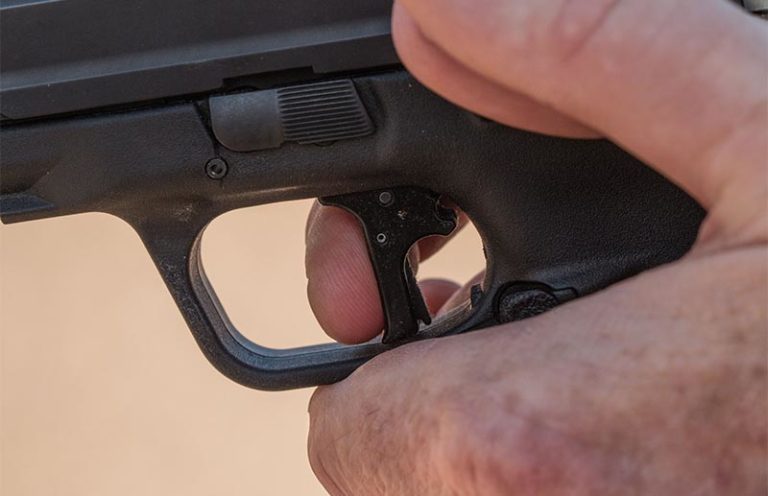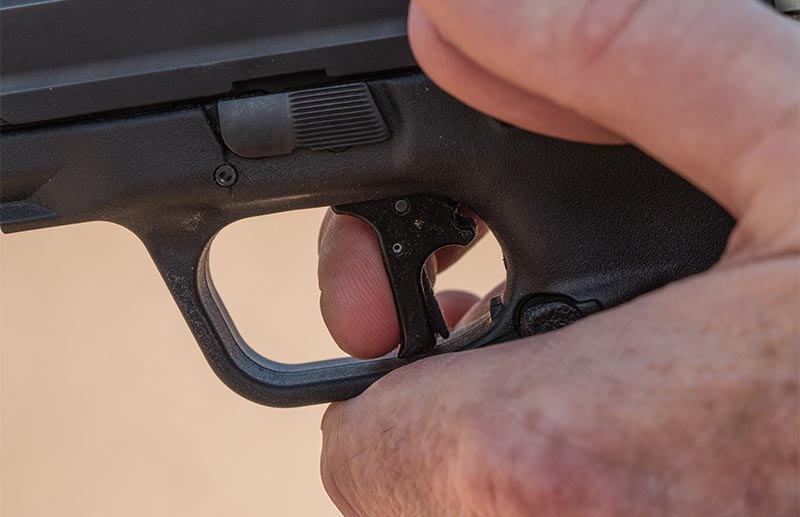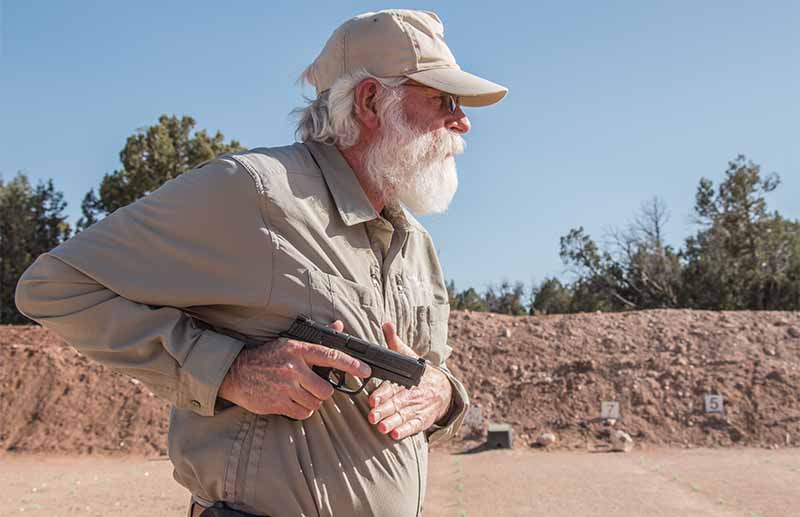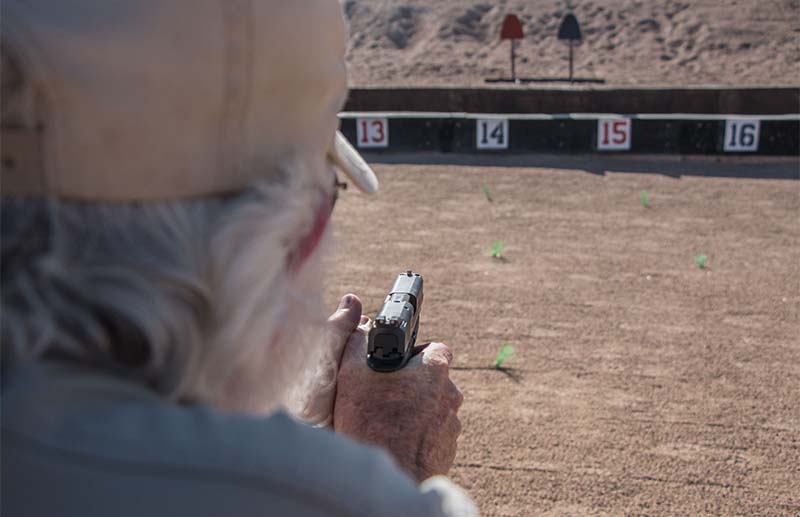
Neither a grip safety nor a manual thumb safety should ever be the primary safety on a defensive handgun.
I’ve always been a fan of defensive handguns equipped with a manual thumb safety. I like them because, when used properly, they eliminate the possibility of a negligent discharge when a handgun is holstered. They can also reduce the potential for negligent discharges when you’re running or handling a handgun during movement.
As important as I feel a manual thumb safety is to a defensive handgun, a manual thumb safety isn’t the primary safety. The primary safety is always your trigger finger.

In most every case where a negligent discharge occurs, the shooter’s finger was on the trigger. This applies to discharges while holstering, moving or handling handguns. There have been some recorded instances where the lip of a heavily worn holster, a tie on the bottom of a hoodie or some other object found its way into the trigger guard and caused the gun to fire, but these are rare. It’s the trigger finger that’s most often the culprit.
Because of this, there needs to be a conscious effort on the part of the shooter to exercise trigger finger discipline. A shooter needs to know when to place their finger on the trigger, when it should be removed from the trigger, and where it should be placed when it’s not on the trigger. Let’s address each of these situations so you’ll know where your trigger finger should be at all times, so you can substantially reduce the possibility of a negligent discharge.
Finger On The Trigger
If you’re not going to fire a handgun, there’s no need for your finger to be on the trigger. The third rule of firearms safety gives us clear guidance here: “Keep your finger off the trigger until your sights are on the target.” Some shooters believe this directive means that unless you’re looking across your sights at the target, your finger shouldn’t be on the trigger.

This literal interpretation of the rule is incorrect because sometimes you’ll engage a target with a defensive handgun when you’re not looking at the sights, such as when shooting from the retention position. (Technically, it could be assumed that if your handgun is pointed at the target, your sights are on the target.)
A more accurate interpretation of this rule would be to keep your finger off the trigger until your handgun/firearm is pointed at the target. This means that when you’re drawing a handgun from the holster you wait until your handgun is pointed at the target before you place your finger on the trigger. Your finger can then remain on the trigger until you point your handgun at something you don’t intend to shoot, begin moving or when you’re satisfied that shooting is no longer necessary.
Finger Off The Trigger
This should be self-explanatory with the simple restatement of Rule 3: “Keep your finger off the trigger until your sights are on the target.” However, just for clarity’s sake, let’s look a bit closer.

When you’ve determined you won’t need to shoot, take your finger off the trigger. Anytime you’re moving and not shooting, take your finger off the trigger. When handling a handgun for any reason other than shooting, such as when reloading, clearing a stoppage or cleaning, keep your finger off the trigger. And maybe, most importantly, anytime you’re attempting to holster or draw a handgun, make sure your finger is off the trigger.
What Does ‘Off The Trigger’ Mean?
After more than a half a lifetime of teaching soldiers, cops and civilians to shoot handguns, it’s clear to me that “off the trigger” doesn’t mean the same thing to everyone. Some think “off the trigger” means the finger isn’t touching the trigger. Others think “off the trigger” means your finger isn’t touching the trigger but it’s still inside the trigger guard, or maybe even resting on the trigger guard. Regarding firearms safety, the term “off the trigger” means your finger isn’t touching the trigger, isn’t inside the trigger guard and is nowhere near the trigger guard.
So, where should your trigger finger be if it’s “off the trigger.” Most firearms instructors will advise that you keep your trigger finger straight along the frame just above the trigger guard. This has been the accepted placement for “off the trigger” in training for a long time.

More recently, to further help diminish the instances of negligent discharges, some instructors are now suggesting that when your finger is “off the trigger” you should index it on the slide so that you can feel the ejection port on a semi-automatic or the cylinder on a revolver.
I’m not so sure that increasing the “off the trigger” distance of your finger is totally necessary, but it’s not a bad idea and it doesn’t negatively impact your ability to swiftly place your finger on the trigger if the need arises. One thing it does do is provide you with a tactile feel and reference point of where to place your trigger finger when it should be “off the trigger.”
If you don’t exercise good trigger finger discipline and keep your finger “off the trigger” when you’re supposed to, there’s probably a greater likelihood that you’ll have a negligent discharge than there’s a chance that you’ll have to use your defensive handgun to save your life. Manual thumb safeties, and even grip safeties on defensive handguns, can be good things, but in their absence and even with them, the best safety you have is your trigger finger. Keep it where it’s supposed to be when it’s supposed to be there. Always!
Editor's Note: This article originally appeared in the November 2021 issue of Gun Digest the Magazine.
More On Defensive Handgunnery:
- 6 Defensive Handgun Drills to Master
- The Shot Timer And Defensive Handgun Training
- Dry Fire Training To Improve Defensive Handgun Skills
- Aiming A Defensive Handgun, Is There One Right Way?
- 7 Steps To Control Fear And Make Sound Decisions Under Stress

Next Step: Get your FREE Printable Target Pack
Enhance your shooting precision with our 62 MOA Targets, perfect for rifles and handguns. Crafted in collaboration with Storm Tactical for accuracy and versatility.
Subscribe to the Gun Digest email newsletter and get your downloadable target pack sent straight to your inbox. Stay updated with the latest firearms info in the industry.

![Best Concealed Carry Guns In 2025 [Field Tested] Wilson Combat EDC X9S 1](https://gundigest.com/wp-content/uploads/Wilson-Combat-EDC-X9S-1-324x160.jpg)


![Best 9mm Carbine: Affordable PCCs [Tested] Ruger Carbine Shooting](https://gundigest.com/wp-content/uploads/Ruger-Carbine-Shooting-100x70.jpg)
![Best AR-15: Top Options Available Today [Field Tested] Harrington and Richardson PSA XM177E2 feature](https://gundigest.com/wp-content/uploads/Harrington-and-Richardson-PSA-XM177E2-feature-100x70.jpg)

Sir:
I started carrying a revolver. About 25 years ago, I switched to Sig P229 and have carried it ever since. I believe the SA/DA hammer guns are about as safe as can be had and negate the need for the mechanical safety that may or may not have been set or may have been inadvertently pushed off for whatever reason. I understand the economics of the plastic, striker-fired sidearms, but believe that heavy though it is, there is no safer hand-gun type.
Actually, I teach that your brain is the primary safety. It controls your trigger finger.
Otherwise, good points. Mechanical safeties can fail.